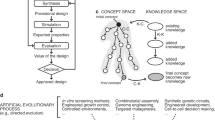Abstract
Many biological processes, from cellular metabolism to population dynamics, are characterized by allometric scaling (power-law) relationships between size and rate1,2,3,4,5,6,7,8,9,10. An outstanding question is whether typical allometric scaling relationships—the power-law dependence of a biological rate on body mass—can be understood by considering the general features of branching networks serving a particular volume. Distributed networks in nature stem from the need for effective connectivity11, and occur both in biological systems such as cardiovascular and respiratory networks1,2,3,4,5,6,7,8 and plant vascular and root systems1,9,10, and in inanimate systems such as the drainage network of river basins12. Here we derive a general relationship between size and flow rates in arbitrary networks with local connectivity. Our theory accounts in a general way for the quarter-power allometric scaling of living organisms1,2,3,4,5,6,7,8,9,10, recently derived8 under specific assumptions for particular network geometries. It also predicts scaling relations applicable to all efficient transportation networks, which we verify from observational data on the river drainage basins. Allometric scaling is therefore shown to originate from the general features of networks irrespective of dynamical or geometric assumptions.
This is a preview of subscription content, access via your institution
Access options
Subscribe to this journal
Receive 51 print issues and online access
$199.00 per year
only $3.90 per issue
Buy this article
- Purchase on Springer Link
- Instant access to full article PDF
Prices may be subject to local taxes which are calculated during checkout


Similar content being viewed by others
References
McMahon, T. A. & Bonner, J. T. On Size and Life (Scientific American Library, New York, (1983).
Bonner, J. T. The Evolution of Complexity by Means of Natural Selection (Princeton Univ. Press, Princeton, (1983).
Peters, R. H. The Ecological Implications of Body Size (Cambridge Univ. Press, Cambridge, (1983).
Feldman, H. A. & McMahon, T. A. The 3/4 mass exponent for energy metabolism is not an artifact. Respir. Physiol. 52, 149–163 (1983).
Schmidt, < Nielse, K. Scaling: Why is Animal Size so Important? (Cambridge Univ. Press, Cambridg, (1984).
Calder, W. A. III Size, Function and Life History (Harvard Univ. Press, Cambridge, Massachusetts, (1984).
Brown, J. H. Macroecology (Univ. Chicago Press, Chicago, (1995).
West, G. B., Brown, J. H. & b. j. Ageneral model for the origin of allometric scaling laws in biology. Science 276, 122–126 (1997).
Enquist, B. J., Brown, J. H. & West, G. B. Allometric scaling of plant energetics and population density. Nature 395, 163–165 (1998).
. Damuth, J. D. Common rules for animals and plants. Nature 395, 115–116 (1998).
Stevens, P. S. Patterns in Nature (Little, Brown, Boston, (1974).
Rodriguez-Iturbe, I. & Rinaldo, A. Fractal River Basins: Chance and Self-Organization (Cambridge Univ. Press, New York, (1997).
Wilson, E. O. Consilience: The Unity of Knowledge (Knopf, New York, (1997).
Acknowledgements
We thank R. Rigon for the computations shown in Fig. 2 ; A. Beauvais, F. Colaiori, P.Dodds, A. Flammini, M. Caterina Putti, R. Robinett, I. Rodriguez-Iturbe, D. Rothman and J. Weitz for helpful discussions; and John Damuth for many key insights. This work was supported by INFN, NASA, NATO, MURST 40% Trasporto di sedimenti ed evoluzione morfologica di corsi d'acqua, estuari e lagune alle diverse scale temporali and The Donors of the Petroleum Research Fund administered by the American Chemical Society.
Author information
Authors and Affiliations
Corresponding author
Supplementary Information
Rights and permissions
About this article
Cite this article
Banavar, J., Maritan, A. & Rinaldo, A. Size and form in efficient transportation networks. Nature 399, 130–132 (1999). https://doi.org/10.1038/20144
Received:
Accepted:
Issue Date:
DOI: https://doi.org/10.1038/20144
This article is cited by
-
Assessments of the environmental performance of global companies need to account for company size
Communications Earth & Environment (2024)
-
Diversity of information pathways drives sparsity in real-world networks
Nature Physics (2024)
-
Impact of physicality on network structure
Nature Physics (2024)
-
Symmetry breaking in optimal transport networks
Nature Communications (2024)
-
Network efficiency of spatial systems with fractal morphology: a geometric graphs approach
Scientific Reports (2023)
Comments
By submitting a comment you agree to abide by our Terms and Community Guidelines. If you find something abusive or that does not comply with our terms or guidelines please flag it as inappropriate.



